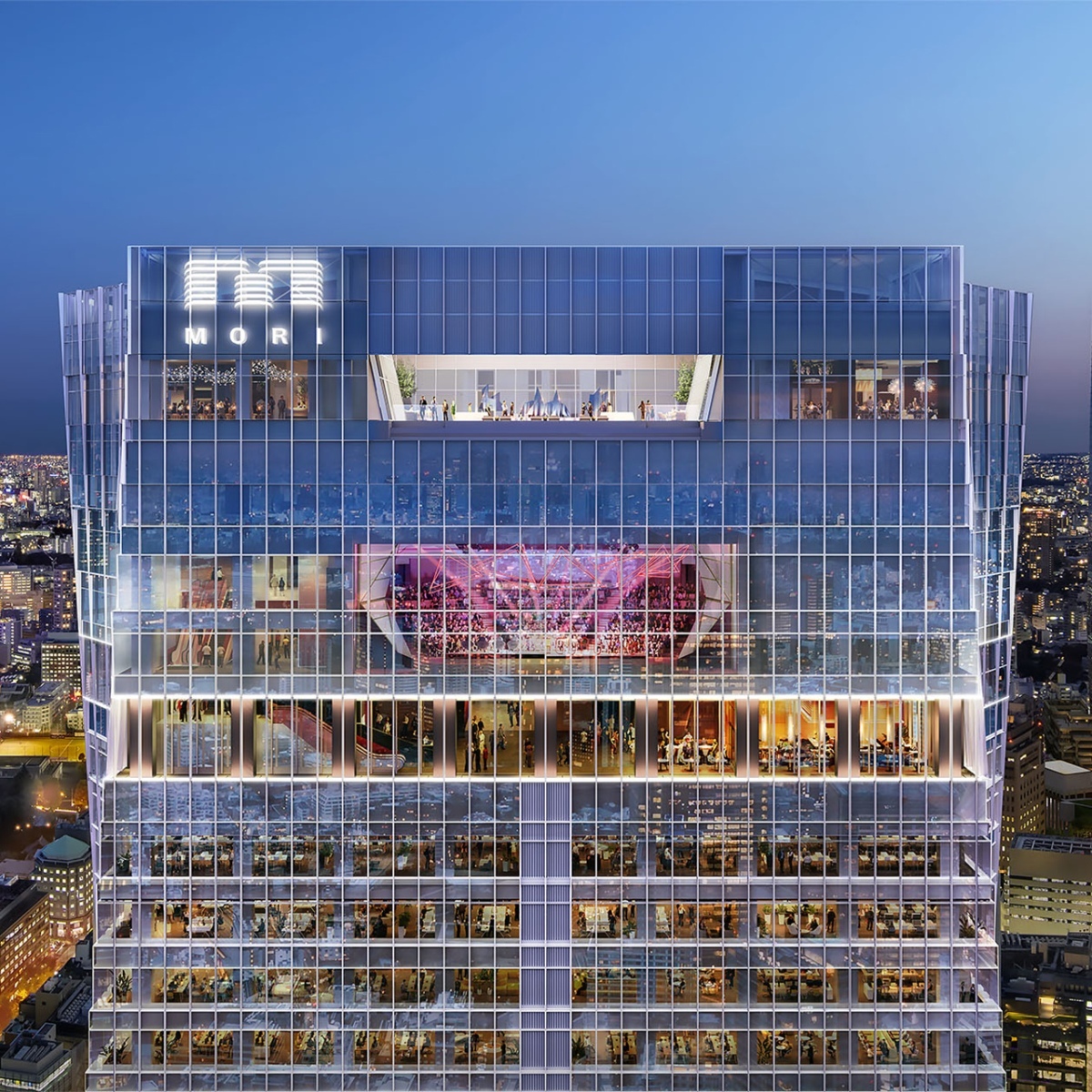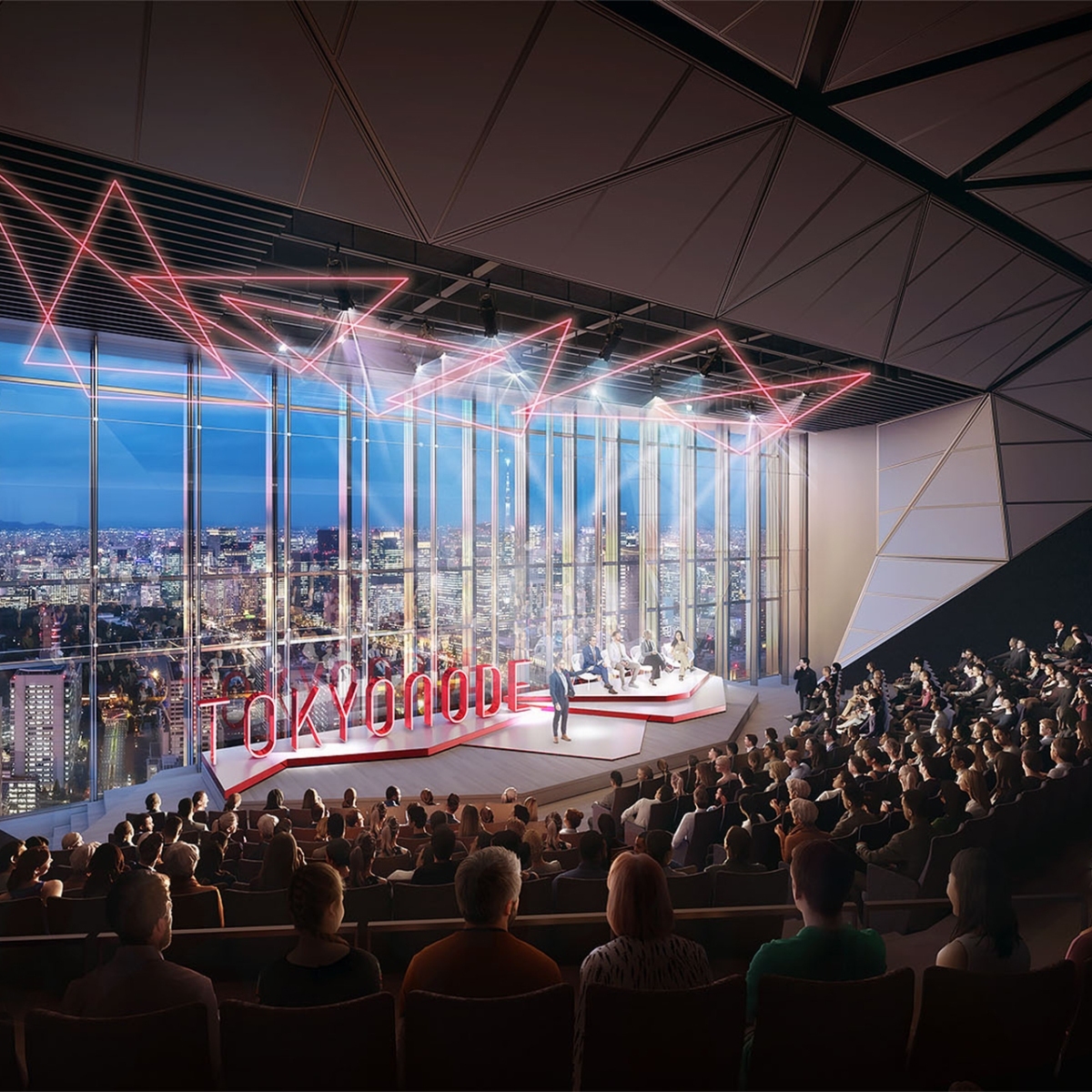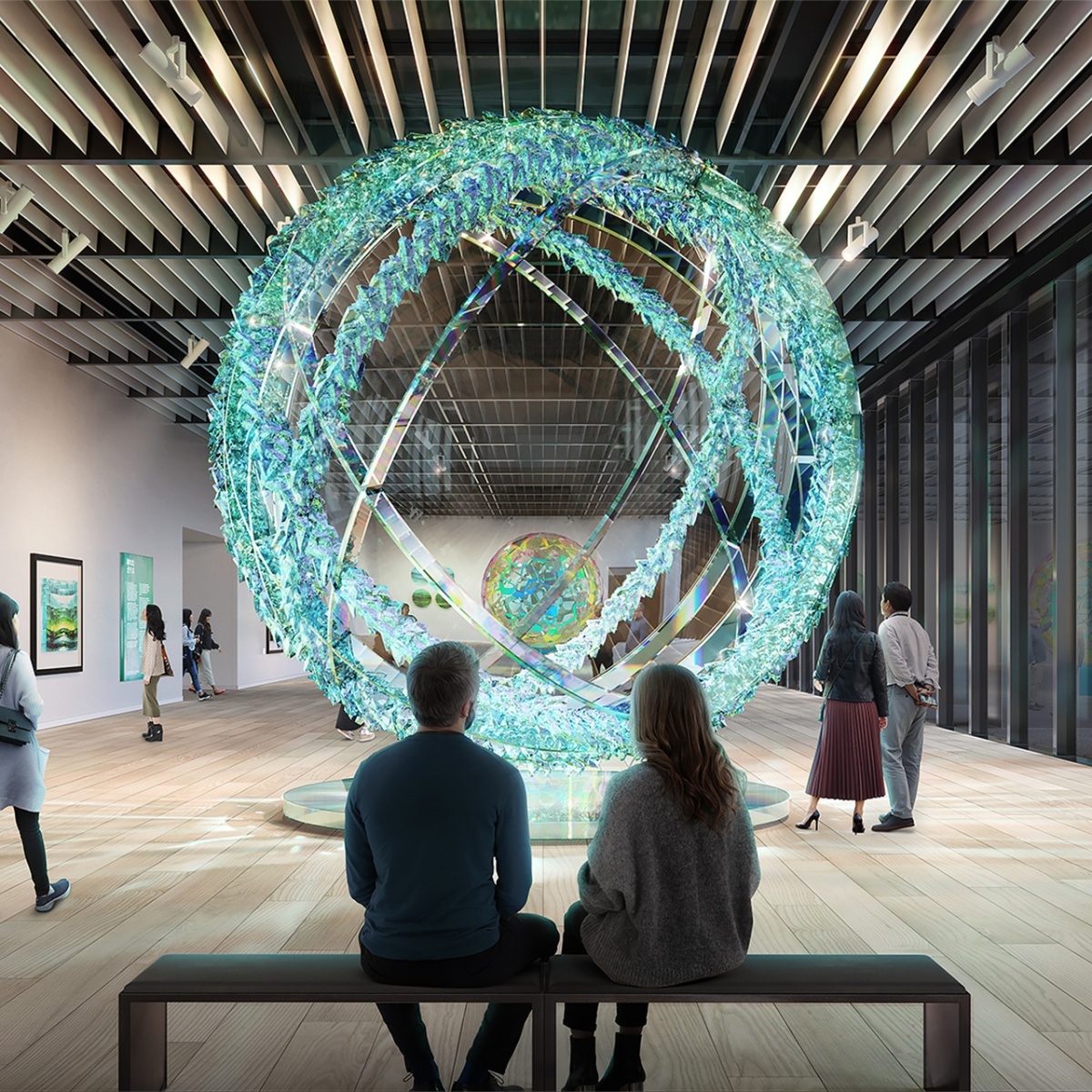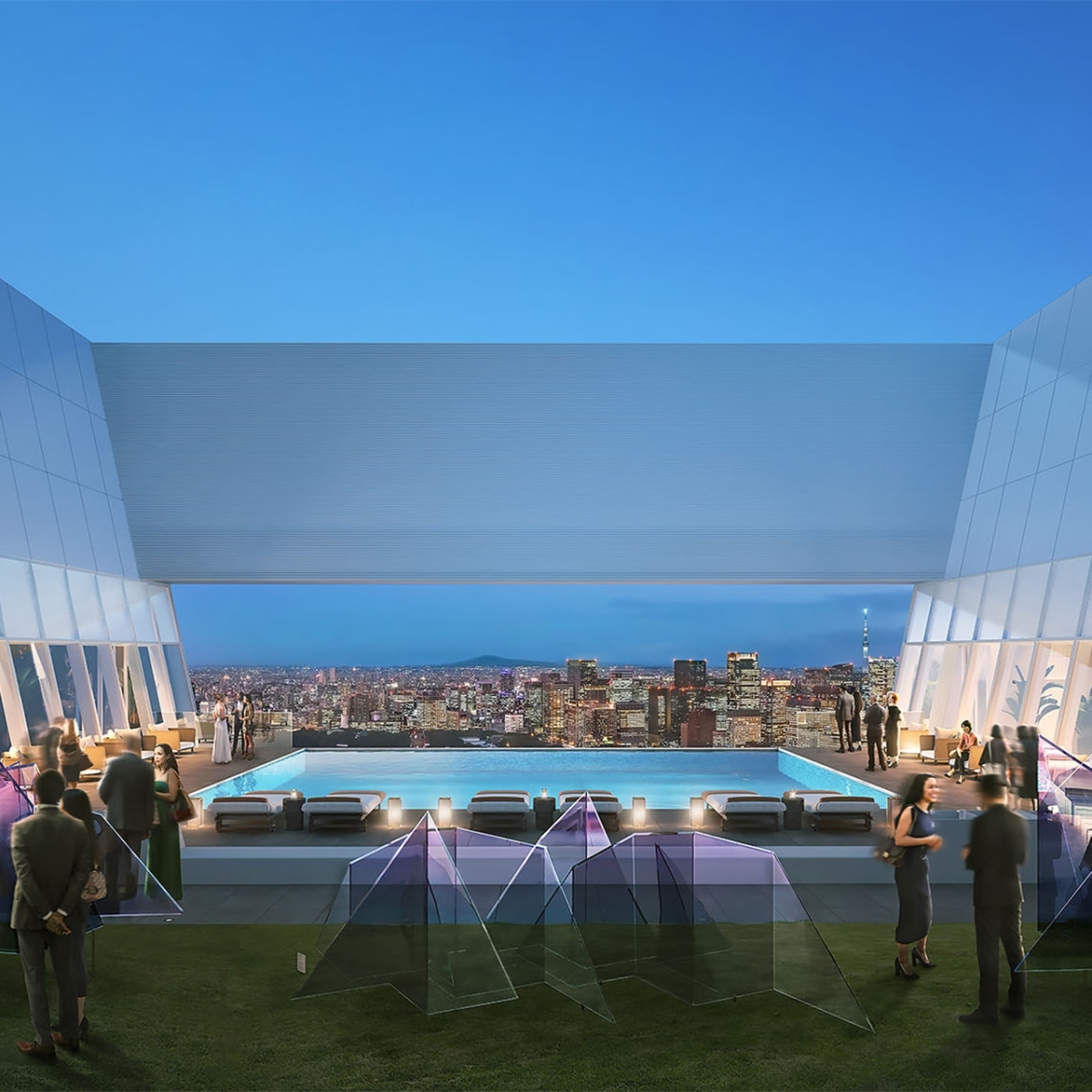
SYNTHESIS OF TECHNOLOGY & SENSATION
Celebrate the opening of TOKYO NODE with Rhizomatiks and ELEVENPLAY! Daito Manabe and MIKIKO discuss their upcoming immersive performance


The inaugural event at TOKYO NODE will take place in the fall of 2023 to coincide with the opening of the new creative hub. Syn: Unfolded Horizon of Bodily Senses is the latest collaboration between Rhizomatiks and ELEVENPLAY, an Immersive performance and novel experiment in integrating the seemingly disparate concepts of technology and human sensation. The two creators—Daito Manabe, co-founder of the creative collective Rhizomatiks, and MIKIKO, director and choreographer of the dance company ELEVENPLAY—discuss what audiences can expect to see unfold in this performance.
TEXT BY Shunta Ishigami
PHOTO BY Kaori Nishida
Translation by Soli Consultants, Inc.
illustration by Adrian Johnson
——Syn: Unfolded Horizon of Bodily Senses, the opening event at TOKYO NODE, will run from October 6 to November 12. Talk us through how the project came about.
MIKIKO It all started with Daito, who came up with the themes he wanted to explore. We then brainstormed the sorts of things that would be interesting to see happen on stage and came up with a performance that is something between an installation and a piece of theater. We’ve been figuring out how to put all the sequences together to give the audience both an emotional and experiential journey that they won’t forget. After the framework is complete, the Rhizomatiks team will figure out the technical aspects.
Creating an entirely new experience

——So MIKIKO came up with the general narrative, which both of you have been updating as you exchange ideas?
Manabe That’s right. Our productions are usually performed in theaters, which means the space is clearly defined and everyone knows their roles. This time, though, we are dealing with multiple spaces connected to each other, all of them quite large, so we’ve been spending a lot of time researching and discussing what we can do.
With one of our previous collaborations, border 2021, we wanted to create an experience that blurred the lines between audience and performer, between the real and the virtual. This time, it looks like we’ll be tackling the themes of physical sensation and creation. We plan to take inspiration from the latest advances in AI tools, especially generative AIs like ChatGPT and Midjourney.

Border 2021 by ELEVENPLAY & Rhizomatiks (February 14, 2021)
——What challenges have you encountered in planning for this event?
MIKIKO The performance spaces are unlike anything we’ve worked with before, and there are much fewer restrictions than when we perform in a typical theater. Having so much freedom is its own challenge! We’re not starting from zero; we’re starting from somewhere below that. So, there is a lot more to think about than in a normal production. For one thing, the audience can move around the performers, so we have to be aware of what’s happening in every part of every space.
——That must require a different approach than when planning for a performance in a conventional concert hall or theater.
MIKIKO Yes. The things that I’m focusing on are completely different from a regular live performance. It’s a challenge, but at the same time I’m so excited to try something new in a brand-new venue like TOKYO NODE.
Confronting anxiety about the future

——What can you tell us about the experience you are designing?
MIKIKO It will not be like sitting down to watch a dance performance. Instead, the audience will move through different spaces as they watch the show. I think it will be a special experience to see the dancers up close, like in an installation. You will be able to enter the installation, so to speak, and viscerally experience the dancers’ movements, facial expressions, and breaths—things you could never get close enough to experience in a typical show. I hope it will be a unique opportunity to gain a deeper understanding of the human body.
Manabe We also want the audience to feel the music like never before, so we’re experimenting with different ways to play the music throughout the spaces. And we’re working with a scriptwriter. His creative ideas are adding an element of narrative entertainment to the performance and have definitely brought a breath of fresh air to our production process.
——So the experience will be more interactive than passive.
MIKIKO Ever since I attended interactive theater productions in New York and London, I’ve been thinking about how to do interactive theater here in Tokyo. So for this project, I thought, “There’s this new place opening in Tokyo this year—what could I achieve here in terms of interactivity?” Another thing that impacted my decision is that every year, Rhizomatiks comes up with a more futuristic topic to explore, like AI and ChatGPT, to the point that it has become hard for me to understand on a technical level. My work, in contrast, has always been about the primal human need to communicate. We hear so much lately about the interactions between cutting-edge technology and flesh-and-blood human beings, and the interactivity is my way of highlighting the human dimension in the performance.
——What kind of production did you feel would speak to Tokyo audiences in the year 2023?
MIKIKO Many interactive theater productions overseas are inspired by historical stories like the Last Supper and the Trojan War. A central part of the experience is seeing the beautiful and well-sculpted dancers perform right in front of you. It’s certainly a wonderful experience, but I thought it would be hard to recreate in Tokyo.
So, first of all, I decided to create a forward-looking work rather than tell a story about the past. While I’m working on it, I find myself thinking less about putting together a sensational performance and more about life in contemporary society. I do feel a kind of vague anxiety about the future, but I hope that by clearing away or acknowledging that anxiety within myself, I can produce a more personal experience that reminds the audience of how each and every person walking through the city has a life and a mind of their own.
The ways in which bodies interpret sensation

——You’ve explained how the performance incorporates physical sensation. How are you planning to incorporate technology?
Manabe I’ve been experimenting with ideas every day. Just yesterday, I was doing an experiment on vision. Everyone uses the same mechanism to see, in that we take in visual information through the retina. But when that information is processed in the brain, each of us interprets it differently. Two people might be looking at the same thing in the same place, but they experience it in different ways. I’ve been thinking about how to make the audience more attentive to those differences. And the same is true of hearing. It gets harder to hear higher frequencies as we get older, and people with perfect pitch or synesthesia have their own ways of perceiving sound. The interesting thing about humans, as opposed to machines, is that each of us perceives things differently even when we take in the same information.
——When you talk about interpreting the same thing differently, I see parallels to what is happening in society today.
Manabe I’ve been exploring the same topics throughout my career as an artist. In electric stimulus to face in 2008, I played music through electrodes attached to participants’ faces, which altered their facial expressions. I found it fascinating that each person had such different expressions even when they were stimulated by the same electrical signals. After all, there’s a big difference between a human face and an electronic display. Much of my art has to do with the complexity of the machine known as the human body and the fascinating ways in which information changes as it is processed by our organs.
——The body is a key element in many of your collaborations with ELEVENPLAY, too.
MIKIKO Instead of incorporating technology for the sake of it, Daito and I have been talking about whether we could have the dancers act as intermediaries between the technology and the audience. I think the interesting part of this performance will be the interaction between people and new forms of technology. I don’t want to think only about technology or create a performance centered on technology; I want to examine what it means for people to communicate with each other.
——In border 2021, you presented the body as a kind of boundary—the interface that links one’s brain and inner world with the world outside.
Manabe I think the worlds inside of our heads are just as complex as the real world. The body is the boundary between them, but it’s a bit low-res—that is, it’s incapable of fully responding to the vast array of information it captures. Our sensors and actuators—by which I mean our sensory organs and muscles—are also low-res. But that’s what makes us interesting. You could say that the body gets in the way of fully expressing yourself, but I believe that it is this limitation that makes artistic expression possible. The ways in which our bodies hinder us are what make our art interesting. I think the difficult and challenging part is to figure out how to work with your body.
A venue where new movements can emerge

——This performance will be your first collaboration since the COVID-19 pandemic began. The pandemic changed many people’s lifestyles and even the nature of entertainment. Do you find that the way in which you create your art has also changed?
MIKIKO Because of the pandemic, for a few years we were unable to savor the sensation of experiencing something in person. The restrictions were lifted recently, and now everyone is remembering what it’s like to feel emotions that they once took for granted. I think people missed it. That’s why, if we were to repeat this TOKYO NODE performance next year, it might be received a little differently. Of course, my goal with any work is to create something timeless. For as long as I’ve been directing, I’ve wanted to give the audience a space where they can affirm their existence and validate their identity.
——TOKYO NODE may also come to serve as an example of how a cultural center can function in a contemporary, post-pandemic city. How do you envision the future of TOKYO NODE?
Manabe In the Dumbo neighborhood of Brooklyn, a growing number of artists and art-related initiatives are changing the area’s energy. And that’s just one example of a phenomenon that’s happening all over the world. But I feel that it’s harder for commercial establishments to achieve that kind of change. People complain that Tokyo, especially, has retail complexes everywhere and that the buildings going up make the city look more and more homogeneous, even if the usage of those spaces differs from place to place. But I think that what Mori Building is doing with TOKYO NODE will completely transform Toranomon.
MIKIKO Personally, I have been bothered by how few places invite artists to present challenging works of art. It felt like a miracle to be given the freedom to do whatever I wanted to do on this collaboration. Other countries have government programs that support performers, but in Japan, artists can only rely on the money they earn from their work to create their next work of art. It would be nice if TOKYO NODE could serve as a catalyst for developing those kinds of programs. Particularly in the dance scene, we get invited to perform overseas much more frequently than we do in Japan, so I’d like TOKYO NODE to create an inviting environment where people from all over the world will want to come and watch the performances held there.
Manabe Overseas, there are organizations like Ars Electronica that provide spaces where both technology and artistic expression can flourish, but today there are few such places in Tokyo—and Japan as a whole. Tokyo used to have several places where artists could experiment and challenge themselves, so I hope that TOKYO NODE will revitalize that scene and give rise to a new artistic movement.
TOKYO NODE Inaugural Event #1“Syn: Unfolded Horizon of Bodily Senses”by Rhizomatiks × ELEVENPLAY

Audiences and dancers alike will embark on a journey of dance
that will deepen and redefine the senses.
Syn: Unfolded Horizon of Bodily Senses is the latest work from Rhizomatiks, the creative collective led by Daito Manabe and Motoi Ishibashi, and ELEVENPLAY, the dance troupe founded by MIKIKO. Audience members become participants in the show as they walk through 1,500 square meters of linked spaces while dancers perform around them. Unfolding without a spoken word, Syn is a treat for all the senses. Visit TOKYO NODE this fall for the world premiere of this groundbreaking interactive experience!
Dates: Oct. 6 – Nov. 12, 2023
Location: Galleries A/B/C, 45th Floor, TOKYO NODE
Tickets: Available from mid-September 2023
Organizer: TOKYO NODE

Daito Manabe
Daito Manabe is an artist, programmer, and DJ. He founded Rhizomatiks, a creative collective, in 2006. Manabe’s work reinterprets and combines familiar themes and materials from novel perspectives. Foregoing high-resolution, super-immersive experiences in favor of experimenting with a variety of genres, he explores the intrinsic appeal of various phenomena, the human body, programming, and computers through careful observation. He also examines the relationships and boundaries within dichotomies such as analog/digital and real/virtual.

MIKIKO
MIKIKO is a director, choreographer, and leader of the dance troupe ELEVENPLAY. She has choreographed and directed live performances for such artists as Perfume and Babymetal, as well as various music videos, commercials, and stage performances. MIKIKO also is highly acclaimed in the media art scene in Japan and abroad. She often collaborates with creators in many different genres to explore ways to elevate new technologies into entertainment.






















SHARE